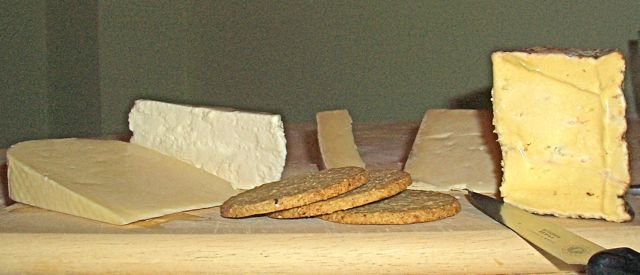Last week I took part in Dan of Food Urchin’s dinner blogging challenge (called ‘Where’s my pork chop?’). Basically I cooked him some dinner and in return I got, well these:
I’m going to be blogging what I cooked for Dan in a separate post so check back for that in the next few days. Here I want to tell you some of what I’ve done with the veg so far.
Dan had been down to his allotment bright and early on the day of the swap and picked me a selection of goodies in their prime. In the bag were charlotte potatoes, curly kale, green (French) beans, courgettes and COURGETTE FLOWERS ?. I’d been hoping for some of the latter as I’ve only tried them once before and they aren’t that easy to buy. We’ve tried to grow our own courgettes this year but we aren’t having much success so far (the first lot of seeds didn’t germinate) so I was particularly delighted with the flowers.
Of course as everything had been picked only a few hours before I took the picture above the veg were absolutely bouncing with freshness. I was pretty pleased with my haul and it really demonstrated how lovely and fresh veg can be when their distance from the ground to the kitchen is short. I now have allotment envy.
So what I have I done with the veg so far?
Well as recommended by Dan I did some of the kale with oil and chilli. I actually steamed it first then gave it a quick sauté in rapeseed oil and chilli flakes. It was really good, the kale still had a little bit of crunch to it and the chilli complemented the slight bitterness that is inherent in brassicas like kale. I’ll definitely try it like this again and venture out into varying the spice choice as well.
The beans and the courgettes we’ve steamed and tossed in a little oil or butter – again when things are this fresh they can shine on their own. And the flowers?




 My nice glossy Norwegian cookbook that my brother gave me
My nice glossy Norwegian cookbook that my brother gave me the chocolatey nutty spread
the chocolatey nutty spread








 Add
Add 
 I was pretty pleased with the result, the leek flavours showed through well and they were soft enough but still with some bite, the cheese contrasted with them nicely and had a good tang and the salad leaves (dressed with just a little extra virgin rapeseed oil) made for a nice soft balance. I think probably the whole goats cheese was a little too much as the egg flavour was a bit lost so when I make this again I’d probably scale back to ½ of the cheese.
I was pretty pleased with the result, the leek flavours showed through well and they were soft enough but still with some bite, the cheese contrasted with them nicely and had a good tang and the salad leaves (dressed with just a little extra virgin rapeseed oil) made for a nice soft balance. I think probably the whole goats cheese was a little too much as the egg flavour was a bit lost so when I make this again I’d probably scale back to ½ of the cheese.